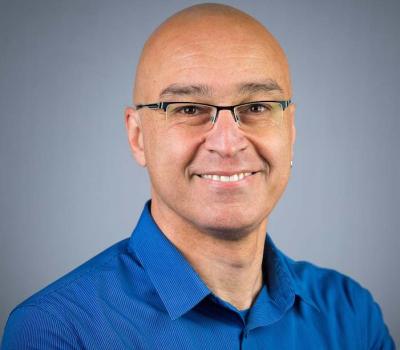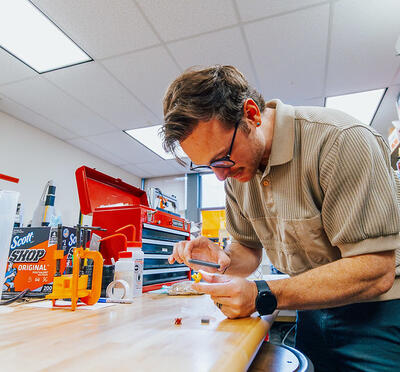CAREER SUCCESS IN ROBOTICS
Where can you go with a degree in robotics from Oregon State University?
This past fall, two recent graduates who launched successful careers at Amazon Robotics returned to Corvallis to inspire current students with stories about life after grad school and to encourage them to maximize their experiences at Oregon State to achieve success in industry.
Eric Klinkhammer has been with the company since earning his master’s degree in robotics in 2018. He works on the software that controls robots in Amazon’s distribution centers and warehouses.
“All of the software that goes from the moment when you click on an order to the robot that actually packages and then delivers that item,” Klinkhammer said.
Logan Yliniemi earned a dual doctorate in robotics and mechanical engineering in 2015. After a two-year stint as an assistant professor at the University of Nevada, Reno, he joined Amazon Robotics as a research scientist in 2017.
“I like working on problems with ridiculously large scale,” Yliniemi said. “When you talk about large-scale problems, Amazon has some of the biggest in the world.”
Today, Amazon commands a virtual workforce of more than 200,000 robots throughout its network of distribution facilities, handling billions of packages a year.
“We’re talking about coordinating tons of robots to do what amounts to a robotic ballet to make sure that they are all constantly being productive and performing some kind of work that’s valuable to getting things out the door to the customer,” Yliniemi said.
Although this “ballet” is performed without an audience, the end results are appreciated by Amazon’s customers every day.
“Everything I do is ultimately going to be seen by my parents, by you — anyone opening up an Amazon package. My robots have touched those items,” Klinkhammer said. “They’ve maybe made those boxes, moved those things around. All of it has a very defined impact on people around the world.”
To the customer, all of the logistics managed by robots are completely invisible. Orders are simply delivered, as if by magic.
“There’s a lot that happens with the robots in the fulfillment center to make sure that we can get the right product in the right place at the right time to be able to fulfill the customer demands,” Yliniemi said.
Both alumni credit their experiences at Oregon State for having prepared them for such rigorous tasks.
“All the faculty here and the classes and the projects forced me to become better in all the ways that industry is looking for,” Klinkhammer said. “Being able to start work without having everything given to you, and work with others.”
Kagan Tumer, the professor of robotics who advised both Klinkhammer and Yliniemi as students, said their success highlights the strengths of the robotics program.
“They and other alumni are becoming leaders in key companies around the world and are great ambassadors for our program,” Tumer said.
Although they graduated only a few years apart, Yliniemi said Klinkhammer benefited from one particular resource he lacked as a student.
“The space in Graf is unlike anything that we had,” Yliniemi said. “This open, sunlit space is a dream come true.”
Graf Hall, the 18,000-square-foot high-bay building that now houses the robotics program, was renovated in 2015 to create a shared, collaborative space for research. Its open plan, with no physical barriers separating research spaces, is designed to stimulate collaboration and interaction among students and faculty researchers.
Since that time, the program has grown to more than 25 faculty and 180 top-notch graduate students who conduct cutting-edge robotics research and applications. It is considered one of the top programs in the country.
The College of Engineering has also established the Collaborative Robotics and Intelligent Systems Institute, whose researchers work to advance the theory, design, development, and deployment of robots and intelligent systems.
“It goes to show how important robotics is likely to be over the course of the next 20 to 50 years, that Oregon State is making such an investment in in resources into the program,” Yliniemi said.




